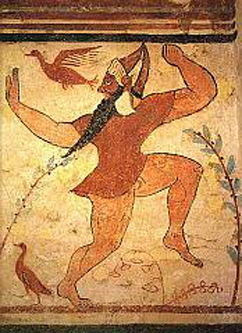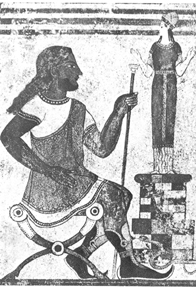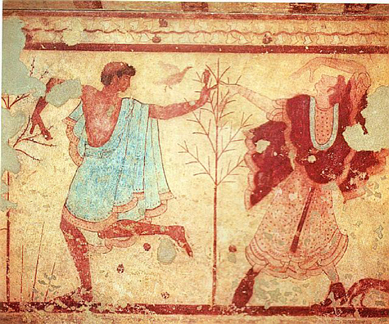Etruscans ~800-200BC
Contemporary Events
- By 800BC the Etruscan culture was well established on the Italian Peninsula
- Chief Etruscan towns were well established by the middle of the 7th Century BC.
- By the end of the 8th Century BC, Greek colonies had settled in Sicily and Southern Italy. By the 6th Century BC, they had reached the southern border of the Etruscan empire. It is the Greeks that gave the name ‘Italy’ to the region, deriving the name from the king of one of the native tribes.

Tomb of the acrobats, detail of a dancer (wall painting). Etruscan / Monterozzi Necropolis, Tarquinia, Italy / The Bridgeman Art Library
This Etruscan woman is wearing the long tunic/tunica called a kolobus-colobium. Using the tunic construction techniques that we have discussed in reference to other civilizations, this Etruscan variation features shaping through the torso allowing for a more “fitted” silhouette and generally falls to the ankle.
She is most likely also wearing a perizoma underneath and some sort of fitted leather shoe. Longer hair worn in multiple braids was very common in the early generations of this civilization. The later generations tended to arrange the hair on top of the head in a fashion similar to Greek women.

6th century B.C. Tarquinia, Tomb of the Augurs
This Etruscan man wears a chitoniskos (a short tunic/tunica). He appears to be bare legged and bare footed, although he is most likely wearing a perizoma as well. Notice his long pointed beard. This a truly Etruscan fashion. His pointed crown hat is a tutulus. The tutulus also has a variation with a rounded crown.
The man below is wearing a slightly longer chitoniskos and a chlamys. His fitted leather shoes are a common element of Etruscan fashion. The latin named given to them is calcei repandi. The female version of this shoe features a slightly less exaggerated point. Usually painted or dyed red, these shoes are a sign of status.


Dancers. 5th century BCE. Tarquinia, Tomb of the Triclinium
The dancers in this fresco below are decked out in very colorful tebennas. A tebenna is a large crescent or semi-circular wrap that could be worn in similar fashion as the Greek himation. It could also be worn in a uniquely Etruscan manner as the figure on the right.
The tebenna is believed to be the true forerunner of the Roman toga.
QUICK REVIEW
TYPE OF DRESS: simple tailoring & some draping
TEXTILES: primarily wool
SILHOUETTE SHAPE: natural hour glass
BASIC GARMENTS: Loincloth (perizoma), tunic layers (chitoniskos & kolobus-colobium), tebenna, tutulus, fitted leather shoes (calcei repandi)
MOTIVATIONS FOR DRESS: Status and decoration
KEY IDENTIFIERS: Tunics, pointed beards, tebenna, pointed shoes, fun-loving activities, often long hair on both genders
Recent Comments